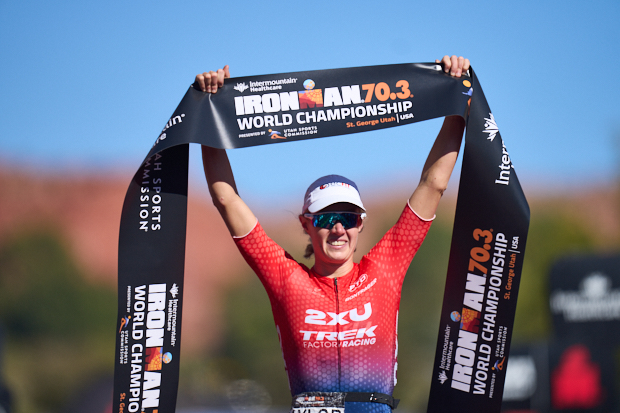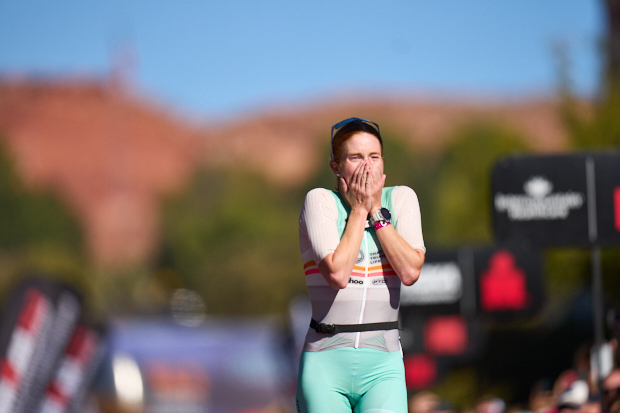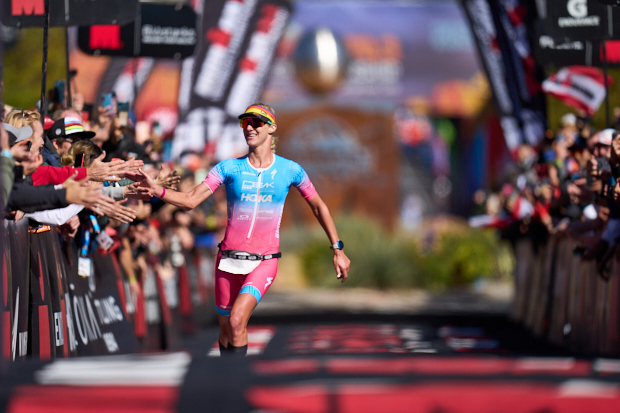Taylor Knibb Dominates IRONMAN 70.3 Worlds

American women are back atop all of long-course racing.
Going hand in hand with an outstanding performance from Chelsea Sodaro at the IRONMAN World Championships in Hawaii, Taylor Knibb won her first IRONMAN 70.3 World Championship in a dominating performance, taking the lead in the early minutes of the bike and never relinquishing that position. Knibb came home in an outstanding 4:03:20 finishing time, nearly six minutes in front of second-place Paula Findlay. Emma Pallant-Browne, meanwhile, passed Lucy Charles-Barclay for the final podium place at the last aid station — a move reminiscent of Chris McCormack pulling away from Andreas Raelert at the final aid station during the IRONMAN World Championships. Charles-Barclay looked for fuel, and Pallant-Browne stomped on the accelerator.
Knibb’s dominance during the race was such that led by nearly 7:30 at the halfway mark of the run, only ceding time to second place Findlay during a short port-a-john stop on that lap. Knibb was overwhelmed at the finish line after claiming her world title: “I can’t really believe it. I just wanted to get to the finish line! That last 10K was very, very long. I can’t believe I made it.”
Knibb was one of many athletes who had taken time during the swim-bike transition to wear additional clothing, with air temperatures hovering in the upper 30s to low 40s. Although she had come out of the water with the then-leading Lucy Charles-Barclay, she gave up that time gap to put on socks and a long-sleeve jersey. Knibb cited that choice as one of the main reasons she was able to take victory: “Someone told me, ‘invest the time in T1.” I’m so grateful to make that decision.”

Findlay was consistently in the chase pack all day, but looked frequently to be in her own zone. That was by design, she said after the race: “It was really amazing. I watched Chelsea’s interview (after winning Kona) about staying in your own moment, racing your own race. I tried to do that all day.” Findlay made the decisive move starting the second lap of the run, opening a gap over Charles-Barclay and eventual fifth place finisher Flora Duffy.

Pallant-Browne was thrilled with her performance, with her first 70.3 Worlds podium since Chattanooga in 2017: “I think just to be back on the podium…I’ve had bad world championships since then. You think it was a fluke. To get third is amazing.”
With a strong swim in the chase pack, it appeared Pallant-Browne was set for a great performance. Coming off the bike, though, Pallant-Browne was well down the standings — 8th place and with more than five minutes to find to get into a podium position. She cited the cold temperatures on the ride as to why she had so much work to do on the run: “I was freezing on the bike, but finally warmed up on the run and got into it.”
Reigning gold medalist and multi-discipline world champion Duffy, meanwhile, took 5th in her debut 70.3 World Championship.
As the Race Happened
With air temperatures in the upper 30s to low 40s, women were bundled in mylar blankets, down puffers, anything warm that they could find, and stayed in the warming tents until the last possible minute to head down to the swim start, and very few actually warming up in the water. With 65 degree water, and with the air temperature, it made for a wetsuit legal swim for the professional athletes. Multiple women were wearing a neoprene cap under their provided cap.
Taylor Knibb lined up directly on the shoulder of Lucy Charles-Barclay. Holly Lawrence was right in the middle at the start. A sprint into the water from the boat launch, with Charles-Barclay slingshotting to the front, reaching the first outbound buoy in under a minute.
A four-person lead group already gapped the field. Charles-Barclay led, with Knibb a few body-lengths back. Flora Duffy and Lawrence were just behind Knibb. By the third buoy, Charles-Barclay had managed to open the gap to the now chasing trio and looked to extend a lead.
About halfway through the swim, Lotte Wilms blew up the small chase pack, and bridged with Knibb up to Charles-Barclay. Ali Brauer led the chasing group, which now contained Lawrence, Duffy, and Emma Pallant-Browne, who was in danger of being dropped off of the group. Paula Findlay was also in trouble of losing the group, continually bumping into another athlete and having to yo-yo their way back onto the feet in the pack.
Charles-Barclay reached the first turn buoy in 10:56, with Wilms and Knibb directly behind. Knibb was gapped coming around the second turn buoy as Wilms attempted to make a pass on Charles-Barclay. The leading chase pack had been whittled down to about 8 athletes and sat roughly 25 seconds back. Duffy, Lawrence, Pallant-Brown and Ellie Salthouse were still in the chase. Findlay, meanwhile, had in fact been dropped.
75% through the swim, and Knibb had managed to claw her way back up to Charles-Barclay and Wilms as the water started to become choppier. At 20:18, Wilms attempted another pass on Charles-Barclay, and the two matched stroke for stroke for the next few minutes, with Knibb getting to come along for the ride as the gap continued to expand over the chasers behind.
Charles-Barclay wound up winning the swim prime in 23:50 — nearly a full minute faster than her leading time last year. Wilms and Knibb were mere seconds behind. Duffy led the chasers, 31 seconds off of Charles-Barclay. Lawrence, Grace Alexander, India Lee, Salthouse were next. Pallant-Brown and Findlay came out of the water together, 1:10 down. Tamara Jewett and some other super runners were over 3:30 down out of the swim.
In transition and many athletes toweled themselves off, added gloves, and wore other warm clothing. Knibb gave up time to put on socks and a long-sleeve aero jersey. Duffy had mylar blankets under her triathlon kit, a wind vest, gloves and arm warmers. Charles-Barclay wore a hat under her helmet, gloves, and arm warmers that she wore about halfway up her arm. Findlay had a long-sleeve jersey over her normal triathlon kit. Some athletes decided to take their chances; Lawrence remained in her traditional bathing suit with gloves the only concession to the weather conditions.
In the opening miles of the bike, Charles-Barclay started off in the lead. Knibb, however, made up all of the time she’d spent putting on warm clothing to charge through to the front, passing Charles-Barclay with what appeared to be ease. Salthouse, meanwhile, had suffered some type of mechanical malady and needed to stop for a quick repair, tumbling down the order to 14th. Knibb sat first, with a small gap to Charles-Barclay and Duffy. Lawrence rode fourth, 30 seconds back. Lee, Wilms, and Findlay (the fastest rider not named Knibb or Duffy at this point) were another 30 seconds behind. Pallant-Browne was 8th, 1:28 off. Imogen Simmonds came 9th, and Rachel Olson rounded out the top 10, 2:10 from the lead.
As the course climbed out of Sand Hollow, Knibb powered away on the climb, smiling and according to course spotters, “not even breathing heavy” as she pulled away. After a quarter of the course, Knibb had 1:13 over Duffy and 1:22 on Charles-Barclay. The big mover behind was Findlay — matching the speed of Knibb on the front and moving up to the rear wheel of Lawrence, now under 1:45 from the front of the race. Lee held steady solo in sixth. The largest group on the road was the trio of Pallant-Browne, Wilms, and Simmonds, around 3:10 off of Knibb. Grace Alexander was now 10th. The last athletes under 5 minutes from the lead — Nikki Bartlett, Salthouse, Jackie Hering, Julie Iemmolo, and Olson.
On one of the many climbs on the way to heading to St. George proper, and the five leading chasers all came together. India Lee led that pack, with Duffy, Findlay, Lawrence, and Charles-Barclay in order next. Knibb’s lead had extended to 2:30 over this group. Of that chasing group, Lee and Findlay appeared to be the strongest, having moved through the pack on the climbs. Wilms, Simmonds, and Pallant-Browne were together, 2:45 off the chasers, and not making progress forward through the field, with Bartlett almost about to bridge to them.
Halfway through the bike, and Knibb’s lead had extended out to 3:10. Findlay held second, with Lee an Duffy in tow. Charles-Barclay found a second wind, and bridged with Lawrence back up to the chase pack. Bartlett had indeed made it to Simmonds, Pallant-Browne, and Wilms, but they now were over three minutes behind the Findlay crew and more than six minutes from Knibb.
The chase group appeared content to let Findlay set the pace on the front. Lawrence, meanwhile, was fighting her way through the pack. It looked like her fellow racers were making her passes challenging — every pass seemed to take the full 25 seconds allowed, and Lawrence had no place to slot back into the pack. During the passes, Lee did not fall back with Lawrence passing her front wheel, and Lee picked up a five minute blocking penalty, dropping to 11th, 9 minutes back. All of this meant that by the 33.6 mile mark, Knibb’s lead ballooned to 4:16. And Lawrence’s passing effort had cost her, as she fell off from Findlay, Duffy, and Charles-Barclay.
Approaching the entrance into Snow Canyon, Knibb grabbed another 30 seconds, sitting 4:46 in front of Charles-Barclay, Findlay, and Duffy. Lawrence stopped the loss, six minutes from Knibb and in a solo fifth. Further back, Bartlett, Pallant-Browne, Simmonds, and Wilms had started to make in-roads towards the front — two minutes behind Lawrence. Lee had settled back into the Top 10, and was joined by Hering, just under 10 minutes from Knibb.
Through Snow Canyon, Knibb rode over a mile an hour faster than anyone else. Findlay and Duffy rode away from Charles-Barclay, but found themselves 6:20 from the lead. Charles-Barclay was another 22 seconds back. Lawrence still sat fifth, 9:01 behind. Wilms was now just 1:20 behind Lawrence. Pallant-Browne, Bartlett and Simmonds were just another 20 seconds back, and Hering completed the top 10, 12:17 from the lead.
Knibb hit transition in 2:40:54, having ridden 2:14:41. She took her time in transition, losing the long-sleeve kit and taking off. Charles-Barclay dug deep during the descent from Snow Canyon and passed Findlay and Duffy. The chase trio ended the bike 6:44 behind Knibb, and they all exited transition together having shed their cold weather gear. To put Knibb’s gap in perspective, she hit the 1.2 mile timing mat just 30 seconds after the chase trio tripped the mat to start the run. Lawrence came solo in fifth, 2:45 behind Charles-Barclay, Findlay, and Duffy. Wilms, Bartlett, Simmonds, and Pallant-Browne came together in a pack, 4:30 off the race for second. Lee completed the top 10, another 90 seconds behind.
On the opening miles of the run course and rolling up to the Dixie Red Hills Golf Course, it appeared that Knibb’s race dominance would also apply to her running. She was running 20 seconds per mile faster than anyone else and now over 7 minutes up the road from Charles-Barclay, Findlay, and Duffy, who were still running together. Further back, Pallant-Browne had jumped up into sixth and was closing down on Lawrence. Simmonds held 7th, Bartlett 8th, Wilms 9th and the slowest runner on the road, and Lee still 10th.
Through the golf course, and Knibb kept pouring it on — more time gained on the chasing trio, who kept running with one another. Pallant-Browne had taken the crown of fastest runner on the road, though, and took over fifth from Lawrence. Further behind, Wilms was about to slide out of the top 10 with Hering running nearly 20 seconds per mile faster.
Halfway through the run and it would take a catastrophe for Knibb to lose her lead, now extended to nearly 7.5 minutes. Findlay and Duffy had separated themselves again from Charles-Barclay, but a 25 second gap was certainly not safe at this point in the race. Pallant-Browne was the fastest woman in the top 10 in fifth, with 2.5 minutes to make up to pass Charles-Barclay. Hering had moved all the way up to 7th, with Bartlett, Lee, and Simmonds rounding out the top 10.
Knibb’s lead was such that she took a port-o-john stop shortly after the halfway mark, ceding a minute of her lead. Findlay, meanwhile, separated herself from Duffy with a push to begin the second lap. Duffy sat comfortably in third, 30 seconds behind Findlay and 30 seconds ahead of Charles-Barclay. Pallant-Browne was now just two minutes behind Charles-Barclay, having taken 30 seconds back in a 1.2 mile stretch. Further back, it was starting to be a question of whether Jewett could run her way into the top 10 — she was 2:10 out of that position but running nearly a minute per mile faster than the women in front of her.
With 5K left to run, Knibb led by 6:08 over Findlay, who now was 90 seconds in front of the third place Duffy. Charles-Barclay, meanwhile, hung very tough, and sat just off the shoulder of Duffy. Pallant-Browne was also just over a minute back from that group, with a chance at making the podium. Lawrence and Hering were battling for sixth, just 30 seconds separating them and matching each other’s pace.
Three kilometers to go, and the battle for the final podium spot was coming down to Charles-Barclay and Pallant-Browne. Duffy had faded to fifth. Charles-Barclay held a 20 second gap over Pallant-Browne, but Pallant-Browne was running 30 seconds per mile faster. At the final aid station, it was Pallant-Browne making the pass while Charles-Barclay reached for nutrition.
Knibb claimed her first IRONMAN 70.3 World Championship in a dominating 4:03:20 performance. Findlay finished second, running a 1:20:33 half marathon to take the silver. Pallant-Browne’s 1:17:45 closing run brought her home in third place. Charles-Barclay backed up her second place finish in Kona with a fourth place finish here. And Duffy hung tough to hold onto fifth place in her first 70.3 World Championship event.
Women’s Top 10 Finishers
1. Taylor Knibb 4:03:20
2. Paula Findlay 4:08:57
3. Emma Pallant-Browne 4:10:45
4. Lucy Charles-Barclay 4:11:24
5. Flora Duffy 4:13:33
6. Holly Lawrence 4:14:15
7. Jackie Hering 4:15:05
8. Nikki Bartlett 4:15:48
9. Tamara Jewett 4:15:57
10. Anne Reischmann 4:16:50

